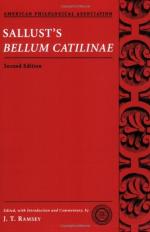|
This section contains 2,405 words (approx. 9 pages at 300 words per page) |

|
SOURCE: Conley, Duane F. “The Interpretation of Sallust's Catiline 10.1-11.3.” Classical Philology 76, no. 2 (April 1981): 121-25.
In the following essay, Conley explores Sallust's account of ambitio and avarita to show that the author does not contradict himself in Bellum Catilinae 10-11, as some scholars have claimed.
It has long been noticed that in chapters 10-11 of the Bellum Catilinae Sallust appears to contradict himself. Chapter 10. 3 states that “primo pecuniae, deinde imperi cupido crevit,” and from the next two sentences, which develop these two concepts respectively, it is clear that Sallust identifies “pecuniae cupido” with avaritia and “imperi cupido” with ambitio. But only two sentences later, in 11. 1, we are told that “primo magis ambitio quam avaritia animos hominum exercebat.” In his recent commentary on the Catiline, P. McGushin expresses his dissatisfaction with existing attempts to explain this apparent contradiction.1 K. Büchner's conclusion that in 10. 3 Sallust names the two vices...
|
This section contains 2,405 words (approx. 9 pages at 300 words per page) |

|


